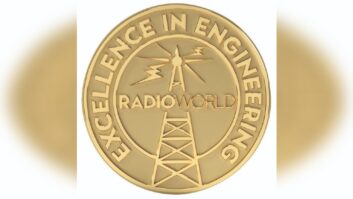Stokes Nielson, founder and CEO of Channel Greatness, has 15 years’ experience in the global entertainment business as a new media entrepreneur, original video content pioneer and award-winning recording artist/producer. He produces content and consults for major brands and international broadcast media companies. He was among the speakers at the recent Radio World Visual Radio Symposium; this interview appeared in the ebook “Visual Radio 2018.”

Radio World: What is Channel Greatness?
Stokes Nielson: Channel Greatness is a global collaborative of creative producers. While our base is in Nashville, Tenn., and I’m a proud Nashvillian, we have content creators all over the world that are constantly looking for new and innovative ways to get their content out. Also we provide original content creation for numerous clients.
It’s a fairly new company, we’re only about a year and a half old, but in that time we have done work with companies like Comcast, Shanghai Media Group, Westwood One and its parent company Cumulus.
One of the reasons I started this company is all of the new ways that you can get great video content out, including radio’s foray into the visual world. At the end of the day, what all media companies are looking for is audience. Radio has a fantastic and loyal audience; so now we’re bridging the gap on how to super-serve this incredibly loyal audience with great robust video content.
RW: You mentioned work with companies we think of as “radio.” What sort of projects?
Nielson: One of our big initiatives was helping people see what was going on when they were listening to Westwood One coverage of major red carpet events, content that you weren’t seeing on TV. More backstage, a lot of intimate interviews, intimate performances occurring around these big events, and finding a way to bring the audience more into those events.
Then people realized that it doesn’t have to be these big events, it can be everyday radio. The audience gets attached to the on-air talent.
Some of the talent that we have in radio … Once you get a camera on them, they’re just as — often more — compelling than broadcast television talent. There is this innovative spark of creativity going on right now in original video content creation from the radio side. On-air talent is realizing, “Wow, this is a whole new way that I can further that connection with the audience.” So for me, it’s a really, really exciting time.
One of the things that I loved about the [Visual Radio Symposium] conference was having those people in the same room and for me to hear from Jenna [Land] and Mic [Fox] about what was going on at Beasley and Emmis. I can remember in 2015 when we did our first backstage shoot with Westwood One at the Billboard Music Awards. People were just starting to realize, “Oh, we’re gonna be able to monetize this.” Very quickly, it’s gone from an afterthought to part and parcel of the business.
RW: For radio organizations that would like to be more engaged, how would you recommend they get started?
Nielson: We live in a time when you can go out and buy an iPhone and it’s going to have a camera on there that will look good, deliver 1080p and be able to grab good light.
Would I love if everybody went out and had access to a [Canon EOS] C300 or something like that? That’s great, but it’s not necessary to get your message across.
What is necessary is that the audience needs to have a pleasing user experience. I am adamant about stability. Make sure your camera is stable. Number two, lighting. Make sure you have proper lighting. You can get portable LED lights; go to B&H Photo and check out some of their portable lighting rigs, it’s not that expensive. They are perfect for studio and non-studio shoots. You want your subject to pop off the screen.
Audio capture is crucial. Stop using the microphone from your camera or your phone that’s capturing all this ambient noise around you, just get a simple lav and little portable Zoom setup so that you get great audio.
Then last, and not least, is the content. It’s just gotta be compelling. Allow your on-air talent to really go for it, and really connect, and really be themselves — the deeper connection that the audience is looking for.
[Video] also allows you to globalize your content. As media in the United States, especially in the entertainment industry, we’re very lucky. Our musicians, our actors, our producers, our directors are valued all over the world — in many countries, valued way more than their own creative talent; and radio, a lot of times, is the front line of getting interviews and insights into these amazing artists. Your interview is not just going to be seen by people in Atlanta or New York or Dallas or whatever your local market is; now it’s going to be seen globally.
It spreads the influence of your station, of your on-air talent, beyond the radius of your listening audience; and that’s exciting, man. Those are simple things that you can do, and then you’re right there in the game.
Once you engage — once you’ve got your quality setup, and you’ve got your on-air talent comfortable with going for it — if you can do it daily that’s great, because you’re going to see that audience grow and grow and grow.
And [work] with other on-air talent and other media companies that need to broaden their audience. This is a great time for those collaborations.
RW: If someone is shopping for a service like yours, a third party to help ramp up video, what tips would you give or mistakes to avoid?
Nielson: Dive in to their promotional reel and make sure that you’re seeing the type of quality content that you need. And [they’ve] got to be reliable and fast.
I’ve so enjoyed working with companies, whether it be Comcast, whether it be Westwood One, that value quality done with reliability and in a cost structure that is fair. So if I’m a company wanting to get involved in this, I have to see a reel that not only excites me, shows me the quality of the content, but also that this company has worked with some pretty big players.
“How long will it take you to turn this around for me?” Those are conversations that you have to have. With a glut of content production companies, reliability and speed are things you never want to suffer from. Your audience deserves to get their content in a timely manner. And it’s got to be somebody that’s reliable.
RW: What else should we know?
Nielson: It’s never too late to dive in. If you’re a radio company or you’re in an independent station and just feel like, “Oh man, I don’t know what to do with all this, I don’t know how …” Part of it is jumping in. You just have to get involved. If you follow just some of the simple steps that we talked about to make sure your video has quality and it has engaging content, you start getting in the game.
But I will say this: The media leaders in radio of the next 10, 20, 30 years, they’re going to be the ones who really know how to harness the power of video.












